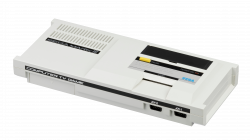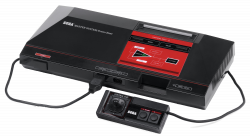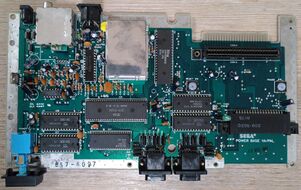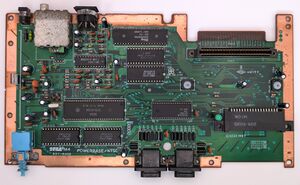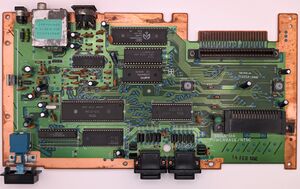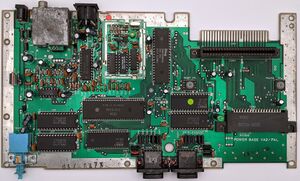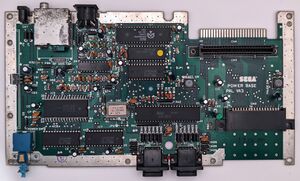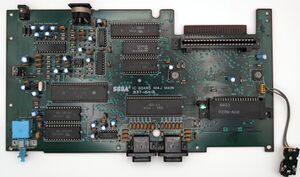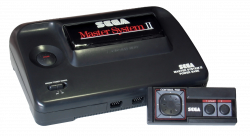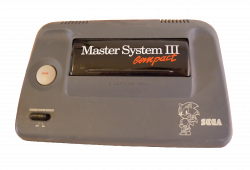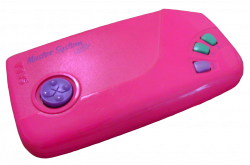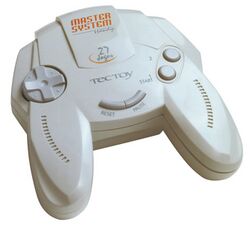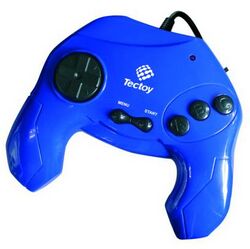Master System Model Differences
There are four main Master System models, with several revisions for the international Master System models.
Models
Models are arranged chronologically.
Mark III (1985-1987)
This is the original release of the Master System hardware, released in Japan on October 20, 1985. The Mark III cosmetically resembles its predecessor, the SG-1000 II, and is roughly the same size as that earlier console. Located on the left-hand side is an expansion port carried over from the SG-1000 line, used to connect the SK-1100 keyboard and the later FM Sound Unit (note that this expansion port is not the same used on later international consoles). Two controller ports are located on the right-hand side (which are numbered in opposite order compared to other consoles) as well as a built-in card slot for reading games on the Sega Card/My Card format. On the back are the power switch, DC input, RF out and AV out. Like the SG-1000 II, the controllers can be snapped onto the sides of the console for storage. The Mark III is also backwards compatible with SG-1000 games, but the color palette is vastly different compared to an original SG-1000 console and may make playing certain games difficult.
Internally the Mark III is fairly similar in construction to its predecessors, featuring a single-sided motherboard and even some of the same parts (e.g. the power switch and leaf switch for the pause button). The Mark III was also the first Sega console to possess RGB output, but it is unamplified and requires external circuitry or modification to make it suitable for most displays. Sega did not sell an official RGB cable in Japan or even acknowledge the fact that it featured RGB output. Unlike all other Master System consoles, the Mark III has no BIOS and I/O is handled with discrete 74xx-series logic chips instead of a dedicated chip. The Mark III is also completely incompatible with the Light Phaser light gun as its controller ports lack the necessary signal for the photodiode inside.
Only one board revision, the 171-5304, exists for the Mark III and all consoles were manufactured in Japan.
The Mark III was also sold by Aaronix in Taiwan, and this version is mostly identical to its Japanese counterpart.[1]
Master System (1986-1992)
The original release of the Master System hardware for the rest of the world. Although mostly internally identical to the Mark III, the Master System is vastly different cosmetically, featuring a black and red color scheme, and is larger than the Mark III. Sega also added a BIOS ROM which handled various functions and integrated the Mark III's discrete I/O chips into a single chip, which now had a provision for reading input from a light gun.
Located on the front are the power switch, controller ports and Sega Card slot, with the DC input, RF out, channel select switch and AV out at the back. The international Master System also has amplified RGB output and a different expansion port located on the bottom of the console, which never saw use. Sega also changed the cartridge port and shape for the West, so Japanese and SG-1000 cartridges are not compatible. SG-1000 cards and some Mark III cards are also not compatible as the international Master System's BIOS prevents them from booting.
Sega put out several revisions of the original Master System over its life, most of which had different built-in games and differing internal construction.
171-5379/837-6067 (1986-1987, NTSC and France)
This is the original NTSC revision of the Master System and was made available in two different bundles, known as the "Base System" and "Master System". The "Base System" featured the console with two controllers and a Hang-On/Astro Warrior combo cartridge, while the "Master System" added the Light Phaser light gun and Hang-On/Safari Hunt as the pack-in game. This revision has the v1.3 BIOS, which displays instructions on how to insert a game when the console is turned on without a game inserted. However, by pressing Up plus both buttons on the controller, a secret Snail Maze game is revealed. Once the player runs out of time to complete a maze, the console resets.
PCB quality on this revision is relatively high and it has double-sided solder joints, making it more reliable compared to most other model 1 SMS revisions. This revision also uses the Sony V7040 video encoder, which produces decent composite video. The 7805 voltage regulator is mounted on a massive heat sink, but unusually the regulator is mounted inward, complicating repairs and modifications as it must be either desoldered with the heat sink still attached, or unscrewed first using a very long screwdriver.
Early French Master System consoles also used this revision, but with the V7040 and RF modulator removed along with their supporting circuitry.[2] Instead, the RGB outputs from the VDP are wired directly to the DIN connector, requiring the use of a special "Adapteur R.V.B." SCART cable which amplifies the RGB to a suitable level for most displays. The VDP was also configured to run at 50 Hz instead of 60 Hz.
NTSC consoles with this board revision were manufactured in either Japan or Taiwan, and have a serial number with "6" or "7" as the second digit.
171-5385 (1986-1987, PAL)
The original PAL revision of the Master System. It is mostly identical to the 837-6067 board, but uses a 53.204 MHz crystal with discrete circuitry to divide down the master clock signal into two, one for the VDP (10.64 MHz) and another for the PAL color subcarrier (4.43 MHz). This circuitry is hidden underneath a small shield which is soldered to the board. Most of these boards have the v1.3 BIOS, but a few have the v2.0 BIOS, which does not perform a header check.
171-5534 "VA1" (1987-1988, PAL)
The second revision for the PAL model 1, marked on the board as "Power Base VA/PAL" and referred to in Sega service documentation as the "VA1", making it the first SMS board revision to use Sega's "VA" naming scheme. This switched out the V7040 encoder with the Sony CXA1145 and changed the Pause and Reset buttons from metal leaf switches to rubber dome switches. This revision still used the v1.3 BIOS, and is equivalent to the 837-6405 revision (detailed below).
837-6405/837-6629/837-6700 (1987-1992, NTSC and France)
These revisions are perhaps the most common for the NTSC SMS, and appeared at around the same time Sega of America handed off distribution of the Master System to Tonka. All of these boards are mostly identical, with the main differences being the BIOS on the latter two, and the VRAM configuration in the case of the 837-6700. The 837-6405 was introduced in very late 1987 and was quickly discontinued seemingly after a few months, while both the 837-6629 and 837-6700 were introduced in mid-1988.
The 837-6405 still used the v1.3 BIOS and came bundled with a combo cartridge, but the 837-6629 and 837-6700 incorporated a built-in game depending on the bundle. The "Base System" featured Hang-On (BIOS v3.4), the "Master System" Hang-On/Safari Hunt (BIOS v2.4), and the "SegaScope 3D" bundle Missile Defense 3-D (BIOS v4.4). Curiously, the Snail Maze game is still accessible on the 2.4 and 3.4 BIOSes by holding Up plus both buttons on startup. It was omitted on the 4.4 BIOS due to its built-in game taking up more ROM space. The 837-6405 and 837-6629 used two 8 KB SRAM chips for the video RAM as before, while the 837-6700 used a single 32 KB PSRAM chip and an additional logic array chip (315-5330) to make this different memory configuration work.[3]
These revisions suffer from reduced build quality compared to the original SMS, which is especially apparent with the motherboard. While the board itself is still double-sided, the solder joints are not, being only plated through on the underside. This can lead to the solder joints for the cartridge and card ports developing cracks, usually causing the console to display a "Software Error" message when a game is inserted. The top outer ground plane is also bare copper and not HASL plated, meaning it can corrode fairly easily. Sega also replaced the V7040 video encoder with the CXA1145. The implementation of the CXA1145 on these boards was not well-executed and composite video is subpar compared to the V7040, with oversaturated colors and low brightness. Sega also swapped out the leaf switches for Pause and Reset with rubber dome switches.
Some French Master Systems use the 837-6629 and 837-6700 boards (despite them being designed for NTSC systems), but with the CXA1145 and all of its supporting circuitry removed and the VDP set for 50 Hz instead of 60. The RGB signals from the VDP are instead output directly from the console and into the Adapteur R.V.B. cable. Some later French Master Systems manufactured in late 1990 also have Alex Kidd in Miracle World as the built-in game.
Both the 837-6629 and 837-6700 were the final revisions for the NTSC model 1. While the model 1 was discontinued in most locales by 1990 or 1991, NTSC consoles with the 837-6700 board were manufactured throughout 1991 and into 1992 for regions such as Mexico[4] and Egypt[5].
Chinese model (1987-1988, PAL)
Not much information is known about this model other than that it appears to have been sold in mainland China beginning in 1987. It is very similar to later PAL models but has the 44-pin cartridge slot used in Japanese and Korean models. The early revision of this model does not have a built-in game, but later revisions appear to have Hang-On built in.
171-5672 "VA2" (1988-1989, PAL)
Another PAL-only revision. This is similar to the VA1, but has a provision for a 1 megabit BIOS ROM. Two variants of the VA2 exist, the 837-6424 (PAL-G) and 837-6473 (PAL-I). The built-in game was either Hang-On, Hang-On/Safari Hunt, or Missile Defense 3-D depending on the bundle. It was the last PAL model 1 to use the 315-5124 VDP and the last to have the discrete clock divider circuit. This board is the PAL equivalent to the 837-6629 revision detailed above.
171-5535-10 "VA3" (1989-1991, PAL)
This was the final revision for the PAL model 1 SMS, and like the VA2 before it, was only used in PAL consoles. This was a rather major revision as Sega began using the revised 315-5246 VDP (which came in an unusual QIP package) and 315-5237 I/O chip, both of which were later used in the Master System II. Like the Genesis/Mega Drive, a 4-pin oscillator is used to generate the master clock signal; this signal then goes into the I/O chip and is divided down for use with the VDP and PAL subcarrier. The built-in game was either Hang-On, Hang-On/Safari Hunt, or Missile Defense 3-D depending on the bundle, while VA3s manufactured starting late 1990 into 1991 featured Alex Kidd in Miracle World instead of Hang-On.
SECAM model (1990)
An extremely rare model which appears to have only been sold in the Soviet Union in 1990. It is by far the most unusual of the model 1 variants, and is the only Master System which outputs SECAM video. Internally it is very similar to the later Master System II, as it lacks a card slot, expansion port, reset button, and only has RF output (the footprint for an 8-pin DIN connector is present but is unused). It also uses the newer 315-5246 VDP and 315-5237 I/O chip found in the PAL VA3 and Master System II, and has Alex Kidd in Miracle World built in.
Master System (MK-2000, Japan) (1987-1988)
For the Japanese market in late 1987, Sega replaced the Mark III with a revised version of the international Master System with extra hardware features. It very closely resembles its international counterpart, but does have some crucial differences. The FM Sound Unit, 3-D glasses adapter and Rapid Fire Unit are all built-in to this console, adding extra value as these were all optional accessories for the Mark III. It still uses the same cartridges as the Mark III and is also backwards compatible with SG-1000 games. This console also has a very distinctive BIOS (v2.1) which plays a rendition of the Space Harrier theme (using both FM and PSG sound) when no game is inserted.
Internally, the MK-2000 is very similar in build quality to later NTSC Master Systems, including the use of single-sided solder joints, rubber dome switches and the CXA1145 video encoder. Unlike international Master Systems, the RGB signals have 75 ohm in-line resistors, which will result in a darker picture if a standard Master System/Genesis RGB cable is used. Sega also eschewed an internal RF modulator, opting for an external unit instead. All MK-2000s use the 837-6418 board revision and were manufactured in either Japan or Taiwan.
This was the final version of the Master System hardware in Japan, as Sega began focusing almost entirely on the Mega Drive by the end of 1988.
Master System II (1990-1995)
A cost-conserving slimmed down version of the Master System, released in 1990 in North America and Australasia[6], and in 1991 in Europe. Noticeably smaller than the original, this version lacks the card slot (meaning no 3-D glasses support), expansion port, composite out, and reset button (French Master System IIs still possess RGB output, albeit unamplified). The cartridge port is also hidden behind a clear plastic sliding door displaying the console name, which cannot be closed with a cartridge inserted. Most PAL models feature an all-black color scheme while all NTSC and early Australian and French consoles have a light gray top half with a white pause button.
VA1 (1990-1993, NTSC and France)
This is the original board revision of the Master System II and is only found in North American and French consoles. Alex Kidd in Miracle World is the built-in game, and the BIOS also displays a simple Sega logo on startup in place of the original animated startup sequence. While it uses the revised 315-5246 VDP like the VA3 model 1, it still uses the original 315-5216 I/O chip instead of the newer 315-5237. The board layout and component footprints are identical between French and North American consoles, but both have some significant component differences. North American SMS IIs run at 60 Hz and only have RF out, while French models run at 50 Hz, have no video encoder, and have unamplified RGB output via the same 8-pin DIN connector as the model 1. French consoles came bundled with a special SCART cable which provided amplified RGB out.
The North American SMS II was only manufactured for a short time in 1990 and was quickly discontinued due to the Master System's fading presence in that market, while the French SMS II continued on until at least 1993. All NTSC models were manufactured in Japan while French models were mainly manufactured in China.
M4Jr. PAL (1990-1992)
The original SMS II revision for PAL regions. It is largely based on the VA1 board with some changes, the most significant being the use of the 315-5237 I/O chip as used in the VA3 model 1. In addition, the pin for controlling video frequency on the VDP is hardwired to 5V (50 Hz). Alex Kidd in Miracle World is the built-in game as before.
M4Jr. PAL 2M (1992-1995)
Appearing towards the end of 1992 for PAL regions only, this is the final revision of the Master System II. The "2M" in the board revision name refers to the two megabit (256 kilobyte) BIOS ROM, which now features Sonic the Hedgehog as the built-in game. In addition, the CXA1145 encoder was replaced with the pin-compatible Fujitsu MB3514. Aside from the BIOS and video encoder, it is functionally identical to the earlier M4Jr. PAL revision.
Brazilian Models
Brazil was by far the most successful market for the Master System, featuring a number of unique console variants that did not see a release anywhere else. This was largely due to the fact that TecToy, Sega's Brazilian distributor, manufactured all hardware themselves and were given wide latitude by Sega to design hardware tailored for that market. Because of TecToy's efforts, the Master System quickly became one of the most popular video game systems in Brazil, to the point where TecToy still sells (emulation-based) Master System consoles.
Note that all Brazilian consoles output PAL-M video, which is the main analog video standard in Brazil. PAL-M runs at the same frequency (60 Hz) and resolution as NTSC, but uses PAL color encoding.
Master System (1989-1991)
The initial release of the Master System hardware in Brazil. It is based directly on the model 1 and came with Hang-On/Safari Hunt built in, but it has some unusual differences compared to most model 1 consoles. Instead of using a standard barrel jack for its power input, the TecToy Master System uses an AC adapter with a 5-pin DIN connector that outputs both 9V DC and 16V DC. This is likely due to its use of the Motorola MC1377 video encoder, which requires 12V as opposed to the typical 5V. In addition, the TecToy Master System only outputs RF or composite video with mono audio through discrete RCA jacks instead of a DIN connector. Aside from these differences, it is largely the same as later NTSC Master Systems.
Master System II (1991-1992)
Despite the name, this is actually a slight revision of the original Master System and hence is not the same as the redesigned Master System II seen in the rest of the world. The only difference of note is that the built-in game was changed to Alex Kidd in Miracle World, with no other hardware changes.
Master System III Compact (1992-2002?)
The Brazilian version of the Master System II. Like the SMS II, the Master System III Compact is a highly condensed, cost-reduced redesign and lacks features such as the card slot, expansion port, AV out and a reset button. Earlier variants of the console have Alex Kidd in Miracle World built in and use an external AC adapter, while later variants have Sonic the Hedgehog built in and also have an internal power supply (a cost-cutting move done by TecToy). These Sonic SMS III Compact systems saw a limited release in Portugal where they were configured for standard PAL video output (including running at 50 Hz) and had an external PSU. A rare variant also exists which has Super Futebol II built in, and a few consoles which had Hang-On/Safari Hunt built-in were also bundled with a Light Phaser.
Internally, the Master System III Compact makes use of a combination of through-hole and SMD components and features either a Sony CXA1145M or Fujitsu MB3514 video encoder. Some Master System III Compacts use the motherboard from the handheld Super Compact (detailed in the section below), possibly as another cost-saving move from TecToy.
Master System Super Compact/Master System Girl (1994)
Released in 1994, the Master System Super Compact and Master System Girl are perhaps the most interesting (and most collectable) of all the Master System variants released by TecToy, as they are semi-portable systems similar in concept to the Japanese Sega Mega Jet. While they lack a built-in screen and require a connection to a TV, they can be powered by four AA batteries. TecToy also released a plug-in RF antenna and receiver unit, allowing them to be used wirelessly albeit with added interference.
The Super Compact is black in color, with a blue D-pad and action buttons and a red pause button. Cartridges plug in at the top, with an extra controller port to the left of it and the power input and RF out on the right. TecToy built in either Alex Kidd in Miracle World, Sonic the Hedgehog or Super Futebol II. Presumably released at around the same time, the Master System Girl is a color variant of the Super Compact targeted towards young girls. As opposed to the Super Compact's simple black with red and blue highlights, the Master System Girl is colored in hot pink with a purple D-pad and pause button, and teal action buttons. Earlier versions of the Master System Girl had Mônica no Castelo do Dragão built-in, essentially a TecToy-created ROM hack of Wonder Boy in Monster Land featuring Brazilian comic character Mônica. Later models had Sonic the Hedgehog as a built-in game and Turma da Mônica em: O Resgate as an extra pack-in game, a TecToy ROM hack of Wonder Boy III: The Dragon's Trap featuring Mônica and her friends.
Internally, the Master System Super Compact is similar to the VA1 revision of the SMS II, as it uses the newer 315-5246 VDP and the older 315-5216 I/O chip. Although the Super Compact only has RF out, it can be easily modified for composite or RGB. For video encoders, the Super Compact used either the Sony CXA1145M or Fujitsu MB3514.
Master System 3 Collection (2002-2007)
Based on the Master System III Compact, this was the last Master System console in Brazil to feature an actual cartridge port. In another cost-cutting move, the Master System 3 Collection actually makes use of a GOAC (Genesis On A Chip) for the main hardware instead of dedicated ICs, with an Altera MAX CPLD running the game selection menu software. When first introduced by TecToy in 2002, the console featured 74 built-in games and used the same 9-pin mini-DIN connector for AV out used in later model Genesis/Mega Drive consoles. Later variants included 105 games built in and had discrete RCA jacks for composite video and mono audio. The number of built-in games eventually increased to 112, 120, and finally 131 by 2007. Starting with the 120-in-1 model, the cartridge connector was removed entirely, though the through-holes and footprint for a connector were still present on the board.
Master System Handy (2004)
The first portable Master System console without a cartridge slot. It had a design similar to a Dreamcast controller along with 27 built-in games. 20 of these were from the compilation 20 em 1, a collection of 20 unique games created by TecToy, while the other seven consisted of Alex Kidd in Miracle World, Bank Panic, Black Belt, Hang-On, Secret Commando, Sonic the Hedgehog, and Woody Pop. Like the Master System 3 Collection, the Handy is based on a GOAC and does not use original Master System hardware.
Master System 3/Master System Evolution (2008-present)
This is the current iteration of the Master System in Brazil. These consoles are entirely emulation-based and do not feature any kind of Sega-derived hardware. Emulation accuracy is rather poor, with games running at an unusual speed and with audio inaccuracies. About 131 games are built in, but a number of these are actually original games which run directly on the console's SoC.
Master System Portátil (Portable Master System) (2009)
The second portable Master System model without a cartridge slot. It is a rebadged AtGames Gear[7], featuring 30 built-in games from both the Master System and Game Gear libraries. Unlike the Handy, the Portátil is an emulation-based system and does not use original Sega hardware. It does however feature an SD card slot, allowing one to play Master System and Game Gear ROMs. Emulation accuracy is fairly mediocre and the audio is slightly higher pitched than original hardware.
Korean Models
Unlike in Japan, the Master System achieved a degree of minor success in South Korea, largely due to the efforts of Sega's local partner, Samsung. Due to South Korea's heavy restrictions on Japanese imports during the late 1980s, most Korean Master System hardware was produced locally in the country. However, Samsung generally did not take much liberties with their hardware as TecToy did in Brazil, and based their consoles entirely on pre-existing Sega designs. Korean consoles also use the same cartridges as the Mark III and Japanese Master System, and are also compatible with SG-1000 games.
Korea OACS Sega Mark III (1988-1989)
This was the first effort to bring the Master System over to Korea, and was essentially a Sega Mark III with some minor cosmetic differences. The only significant internal difference is the lack of a card slot, despite having an opening for one.[8] This means that card games will require the Japanese Card Catcher add-on, and 3D games will not play properly unless they have a 2D mode.
An obscure company named Korea OACS manufactured the Mark III, with Samsung handling distribution. Unusually, Korea OACS and Samsung positioned the Mark III as a home computer and intended for it to be paired with the SK-1100 keyboard, which ultimately never saw a release in Korea. The Korea OACS Mark III is extremely rare, as it was only produced for a few months before being discontinued.
Samsung Gam-Boy (1989-1991)
In April 1989, Samsung replaced the Korea OACS Mark III with the Gam-Boy, which was marketed as being a pure game console as opposed to an expandable home computer. The Gam-Boy is based on the Japanese Master System console and also includes some of its built-in features except for FM sound capability. At least three different cosmetic revisions of the Gam-Boy exist. The earliest has the text "Gam-Boy Home Computer System" as a sticker on the top shell, covering up where the system name would be on an original Sega console. This revision was also entirely manufactured in Japan. The second revision has the Gam-Boy text properly silkscreened on the top shell, while a later revision has the "Gam-Boy" logo in Hangul ("겜보이") instead of English. Samsung only manufactured the plastics for the second revision, but by the third revision, all Gam-Boy consoles were being entirely manufactured in Korea.
For the latter two revisions, Samsung also began packing in controllers of their own design, which use a small, rounded-off design with a Nintendo-style D-pad. Some Gam-Boy consoles have an internal power supply while others use an external AC adapter. The Gam-Boy uses the same v2.1 BIOS as the Japanese Master System which it is based on, right down to featuring Japanese text. Since the Gam-Boy does not have FM audio, only the PSG portion of the Space Harrier theme plays on the BIOS screen. Japanese-manufactured Gam-Boys use the 837-7074 board revision, which is similar to the one used in the Japanese Master System but without the YM2413 and with a different I/O chip (the 315-5363).
Samsung Gam-Boy II/Aladdin Boy (1991-1995)
As Sega did in the rest of the world, Samsung eventually replaced the original Gam-Boy with a cost-reduced redesign, known as the Gam-Boy II. It is directly based on the Master System II, with the only real difference being the cartridge slot as Samsung continued to use Japanese-style cartridges. Late in 1992, Samsung began changing the names of most of their systems, with the Gam-Boy II being renamed to the Aladdin Boy. Early Aladdin Boy consoles are largely identical to the Gam-Boy II, with the only differences being the name on the cartridge slot door, and the lack of a channel select switch. Much like the Master System II, the console had Alex Kidd in Miracle World built in, albeit a localized version with Korean text.
In 1995, Samsung revised the Aladdin Boy with an unusual two-tone color scheme, featuring a bright teal top shell, purple bottom shell and power switch, and a yellow Pause button. The RF output was also replaced with a 9-pin mini-DIN connector, allowing it to output composite video and RGB. Samsung also replaced the original two-button controller with a matching 3-button Super Aladdin Boy (by then the Korean name for the Genesis/Mega Drive) controller, even though the Aladdin Boy could not take advantage of its extra two buttons.
Links
https://en.wikipedia.org/wiki/Master_System
https://en-academic.com/dic.nsf/enwiki/5908108
https://gametrog.com/sega-master-system-information-specs/
https://segaretro.org/Master_System_consoles_in_North_America
https://www.smspower.org/Development/HardwareImages-Index
https://gametrog.com/sega-powerbase-converter-information-specs/
https://bbs.ruliweb.com/hobby/board/300431/read/30557190
https://blog.naver.com/whddls1000/150137179599
References
- ↑ https://www.smspower.org/forums/15642-TaiwanAaronixMarkIIIKoreanOacsMarkIIIKoreanSamsungMasterSystem
- ↑ https://www.pimyretro.org/sega-master-system-fm-sound-expansion-module/
- ↑ https://www.smspower.org/forums/10098-3155246And3155330Pinouts
- ↑ https://www.smspower.org/forums/15992-SMSInMexico
- ↑ https://www.smspower.org/forums/16060-ModelSerialNumberRequest#131109
- ↑ https://retrocdn.net/images/a/a4/Megazone_AU_09.pdf
- ↑ https://segaretro.org/Arcade_Gamer_Portable
- ↑ https://www.reddit.com/r/MasterSystem/comments/1ell8ql/the_korean_sega_mark_iii_has_an_empty_card_slot/
